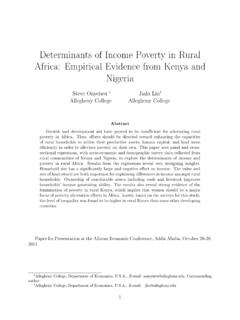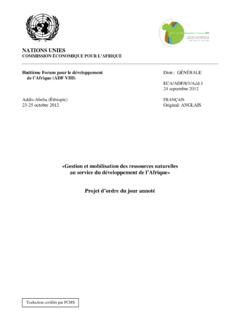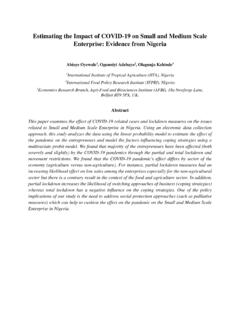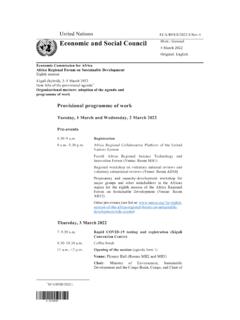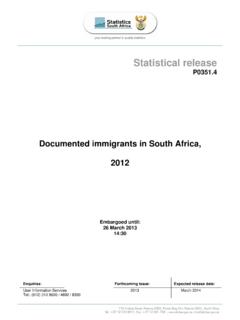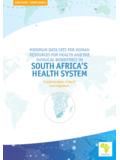Transcription of African Migration
1 African Migration Drivers of Migration in Africa October 2017. Draft Report Prepared for Africa Regional Consultative Meeting on the Global Compact on Safe, Orderly and Regular Migration 1. Acknowledgements The present draft report on the Drivers of Migration in Africa was commissioned by Economic Commission for Africa (ECA) as a background document for the Africa Regional Consultative Meeting on the Global Compact on Safe, Orderly and Regular Migration . The report benefitted from the overall guidance of Ms. Thokozile Ruzvidzo, Director of the Social Development Policy Division (SDPD) of ECA. The draft report was prepared by Hein de Haas (Lead Consultant), and also incorporates insights from the sub-regional reports prepared by Papa Demba Fall (West Africa), Pierre Kamdem (Central Africa), Caroline Wanjiku Kihato (Southern Africa), David Gakere Ndegwa (East Africa) and Ayman Zohry (North Africa).
2 William Muhwava, Chief of the Population and Youth Section, Social Development Policy Division (SDPD) of ECA provided technical leadership, substantive guidance and supervision in the preparation of the report. The report team comprised Gideon Rutaremwa and Mamusa Siyunyi of the Population and Youth Section, SDPD, ECA. 2. Introduction An important focus of the Global compact on safe, orderly and regular Migration consultative process has been on addressing the root causes of Migration so that Migration becomes a choice not necessity. Motivations to migrate arise from a combination of factors such as demographic shifts; lack of employment opportunities, especially for the young; endemic poverty; natural disasters;. income inequality and perceptions of unequal distribution of wealth; conflict; and economic and political instabilities.
3 Africa is often seen as a continent on the move due to crisis-led causes, mainly as people escaping poverty, environmental disaster, or violent conflict. the premise of poverty-driven Migration out of Africa has been disputed by current research. African countries with comparatively higher levels of development, such as in the Maghreb, coastal West Africa, South Africa etc also tend to have the highest intensity of extra-continental migration1. The changing structure of labour demand Common explanations about African Migration focus on factors such as poverty and conflict in origin countries obscure the crucial role of labour demand. The dynamics of labour demand in African , European, Middle Eastern and other overseas labour market are a key factor in explaining changing patterns of intra- African Migration as well as the recent increase of overseas emigration from sub-Saharan Africa.
4 In particular, the segmentation of European and Middle Eastern labour markets into a higher skilled, formal sector and a lower skilled, often informal sectors, together with rising living standards and levels of education as well as ageing, has led to a persistent demand for migrant labour in the informal labour markets of comparatively wealthy destination societies, in which case migrant workers typically do the manual jobs that local workers are unwilling or unable to do (Castles, de Haas and Miller 2014; Massey et al. 1993; Piore 1979). This is not just the case in Europe and North America, but also for the Gulf countries, where the state-sanctioned creation of an extremely segmented labour markets through kafala or sponsorship system are key institutional drivers of the demand for female domestic workers (Fernandez 2011).
5 At the same time, the increasing demand for skilled migrant workers, which is increasingly favoured by skills selective immigration policies (Czaika and Parsons 2017; de Haas, Natter and Vezzoli 2016), is also motivating relatively modest, but increasing numbers of young, skilled African to migrate overseas to work and/or study. This explanation does not solely apply to overseas Migration to the Gulf and Europe, but to a significant extent also to rural-to-urban Migration within African countries as well as Migration between African countries (such as refugee women working as domestic workers in Cairo, see Ahmed 2003) or within African countries, such as of domestic and construction workers (for Ghana, see Awumbila et al. 2017). While male migrants typically work in sectors such as construction, industry, and intensive agriculture, an increasing number of women have been migrating within and between African countries as domestic workers as part of a broader trend towards feminization part of a broader trend towards feminization of Migration .
6 1 Jonsson, 2009. 3. Empirical studies indicate that that, notwithstanding the dangers, humiliation and discrimination migrants regularly go through, also such internal Migration generally does pay off in many cases, in terms of providing better long-term economic and educational opportunities for migrants themselves and, particularly, for their families (cf. Awumbila et al. 2017). This also fits within other empirical evidence from Migration occurring under conditions of poverty and high constraints, that ( internal ) Migration is often part of household strategies to diversify income in order spread livelihood risks (see De Haan et al. 2000 on Ethiopia and Mali). It is vital to acknowledge the vital role of destination country labour demand in motivating people to migrate, as this is a key factor in explaining the continuation of African Migration to other African countries, Europe and the Middle East, whether legally or illegally, in spite of Migration restrictions and border controls.
7 Developmental drivers of Migration While labour demand and business opportunities in domestic and international destination areas plays a key role in motivating people to migrate, origin country development in the form of rising incomes, increasing education and infrastructure connections shape the conditions that initially tend to increase people's aspirations and capabilities to migrate. This is the opposite of what push-pull models would predict. Long distance Migration in particular involves significant risks and costs, and the higher educated more often seek jobs, working conditions and life styles that are scarce in origin areas. This helps to explain why African countries with relatively higher levels of economic and human development (such as Morocco, Algeria, Tunisia, South Africa, Ghana and Senegal) tend to have comparatively higher extra-continental emigration rates than the poorest African countries (such as Chad, Niger, Mali and South Sudan).
8 The main exceptions on this rule are the large overseas refugee migrations from Somalia and Ethiopia. From the Migration research literature, there is ample evidence that economic development and social transformation in low-income countries is initially associated to increasing rather than decreasing levels of rural-urban Migration and international out- Migration (Zelinsky 1971). This is because modest income growth, improving infrastructure, increasing education, and access to media, tends to increase both people's aspirations and capabilities to migrate over increasingly long distances (de Haas 2010b). This partly explains the paradox why middle income countries such as North African countries and South Africa, tend to have the highest levels of extra-continental emigration rates.
9 Only when societies become wealthy emigration decreases and immigration increases, after which which transform from countries of net emigration into countries of net immigration. Such Migration transitions often occur together with demographic transitions: Emigration rates tend to be highest not in countries with the highest population growth, but rather in countries where high past fertility results in a youth bulge', or a high proportion of Migration -prone young adults (cf. Skeldon 1997). This hypothesis of a Migration transition has been empirically tested using historical (Hatton and Williamson 1998) and contemporary (Clemens 2014; Czaika and de Haas 2012; de Haas 2010) Migration data from countries around the world, and also seems to apply to the African case, as extra-continental Migration from Africa is dominated by countries with relatively high levels of economic and human development.
10 4. It therefore seems relative poverty resulting from rising aspirations combined with better opportunities and more attractive lifestyles elsewhere that drive the bulk of African Migration rather than absolute poverty. At the same time, improved infrastructure, cheaper transport, the rapid diffusion of telecommunication techniques such as mobile phones (cf. de Bruijn, Nyamnjoh and Brinkman 2009; Schaub 2012), and improved education are likely to have increased awareness of opportunities in other countries and, hence, people's Migration aspirations. As long as people's changing lifestyle preferences and increasing material expectations cannot be met locally, this typically translates in increasing aspirations to migrate, either to towns or cities, or abroad.


